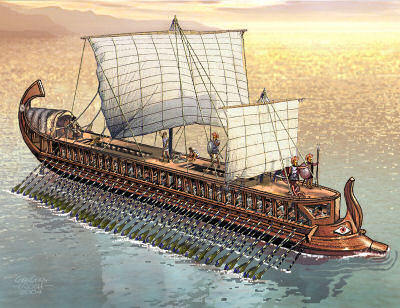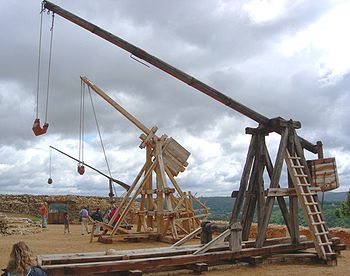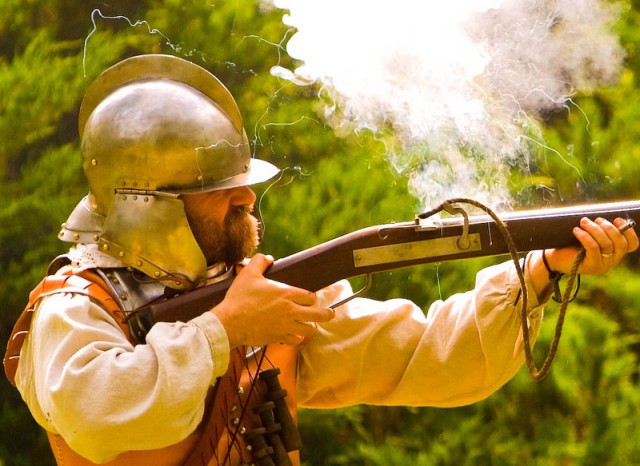One must consider was it technology that was fostered by war, or was it war that fostered technology? The two are forever linked in history as structures of man’s escalation of control and dominion over the Earth. It was technology that allowed man to conquer and colonize every continent on the planet, but it was war that gave society impetus to do so.
It can be argued that it was the innovation of the phalanx in Western culture that was the first progeny of technological warfare, but to be truthful prior to the rise of the Greek city-state there were tens of thousands of years of amazing development of crude weapons and the use of them on other tribes in the form of limited engagements, battles, and cultural wars.
As the Greeks were refining their hoplite technology, which included the phalanx as well as the panoply of breastplate, greaves, helmet, shield and spear, the Persians were cultivating their Immortals, a strong imperial force that was highly mobile and maneuverable. This came to a head with the battle at Marathon in 490 BCE in the first Greco Wars. In the battle of Thermopylae in 480 BCE the forces clashed in a historical battle that left the Persians humiliated and the losers even though they outnumbered the Greeks 20 to 1. Once again the Persians and Greeks fought a battle of Salamis in which the older and slower naval fleets sparred with the Greeks trireme and discovered again that sheer numbers do not mean victory.
The trireme was an advancement of the Greeks brought about by the explosion of technological achievements after the Dorian empire faded and the Greek city-state blossomed. The ship had a very shallow draft, less than three feet but was able to sustain speeds of four knots and a ramming speed up to ten knots. The speed with the addition of a giant ramming horn was the primary attack of the ship, much like the phalanx that was all about forced thrusting force upon the enemy. The trireme was the backbone of the Delian League and was more than 120 feet long with as many as one hundred seventy oarsman.
Phillip the 2nd, the father to Alexander the Great, brought all of Greece under his control in 338 BCE by using Macedonian infantry utilizing eighteen fot long spears, lighter armor, and a refined use of phalanx tactics. Alexander continues to use these tactics, but being a highly educated general, he also uses new developments of warfare including the siege engine.
The siege engine is a large apparatus used to bridge castle walls and sometimes used to throw projectiles such as stones, but also could throw dead cattle for an early form of biological warfare. There were many names for these devices such as a catapult, scorpion, and trebuchet.
Romans developed and refined the idea that all males of a society served in the army. It was typical for a Roman citizen to serve sixteen years in the infantry or ten years in the cavalry. Upon completing the “tour of duty” the soldier was allowed to retire and gain 2 acres of land, but these men were always still required to defend the local lands and could be called upon to fight in the legions at any time. The Romans had a triple axis of men with the Hastati (young men) the Pricipes (experienced veterans), and the triarti (the older men). The standard panoply of the Roman soldier was a two foot long sword called a gladius, a short spear called a pilum, simple armor of either boiled leather or chainmail, and a large rectangular shield. The Romans embraced Total War, unlike the Greeks who disdained its use. Romans were always on the offensive, much like the Greeks, but waged war at any cost and fought enemy soldiers as well as citizens of other empires. Rome developed most of its strategies and tactics during the three Punic Wars that they fought with Carthage. Towards the end of their reign, the Romans continued use of general phalanx style combat caused havoc and continued losses against the Barbarian Horde against such people as the Goths and Attila the Hun.
In the medieval era, technology and war found a new consort with religion, which changed why war was waged. Instead of fighting a specific civilization or an area of the map, the new paradigm of war was fought against religious differences; thus the Crusades or the Jihads. The Aristocracy was landed nobility based on a feudal society, where knights were drawn from the aristocracy and peasantry were serfs drawn from the feudal holdings. It was because of the Crusades that resulted in the Magna Carta, which changed the political discourse of Western civilization.
It was during this period that saw the development of the fifteen foot pikes that were used to thwart heavy cavalry. It also saw the development of the long bow, which was used in the battle of Agincourt in the year 1415 and that provided enough physical power to negate the capabilities of heavy armor. Slowly the soldiers were changing from noble gentry with heavy plate armor and highly trained war horses, to divisions of serfs with little armor and guns that required little training to aim, shoot, and load.
Shortly thereafter, the invention of black powder in China, circa 800 CE, and its subsequent import into Europe by 1324 in early gunpowder weapons such as the arquebus started to be used in battle. By 1350 the first handguns were being used in Europe, notably the hacquebutts and arquebutts. Cannons and bombards, heavy bronze guns invented in 1400, fired cannonball projectiles at walls, defenses, ships, and at groups of men in tight formation.
The rifle went through several iterations of improvement as black powder changed into smokeless gunpowder and the barrels of the guns became rifled which led to better accuracy. The firing mechanisms of guns also improved. Originally guns were fired from a lit tap at the breach of the gun, but this was augmented with the matchlock that struck flint to steel and caused a spark.
It was during the final stages of the American Civil War that saw breach loading guns; instead of pouring gunpowder down the barrel and tapping down the powder and then firing it with a matchlock mechanism, a shell of metal encasing both the bullet and powder was loaded into the gun. Up until the Civil War, forces still marched in phalanx style squares of soldiers. With the invention of the rifled gun, however, accuracy improved so much as to make marching in formation suicidal.
During World War I, led to guns with magazines that could fire anywhere between six bullets to thousands of bullets before being reloaded. Consequently, the invention of the machine gun turned simple hand guns into deadly weapons that could spray the battlefield with high cyclic rates of shells. The invention of explosives other than black powder, such as nitro glycerin, manifested into HE (High Explosive) rounds used to penetrate armored vehicles and fortified positions.
The turn of the century also saw the innovation of many new forms of combat technology including trench warfare, tank warfare, chemical weapons, aerial dog fighting, aerial bombardment, mortars, machine guns, and artillery. Trench warfare was brought about by the inability of either side to conquer the enemy territory, thus resulting in trackless miles of ditches where men slept, ate, and died. New diseases ravaged these heinous muddy prisons such as trench-foot. Chemical weapons were tried to dislodge enemies from their trenches and included the use of Chlorine, Mustard, and Phosphate gas.
It was also during this time that aerial vehicles were starting to appear in the skies over battlefields. Airplanes allowed warriors to disengage themselves from the terrain and to fly directly to the enemy’s cities and manufacturing sites, circumventing the need to initially take control of large expanses of enemy controlled land.
Aerial bombardment reached an apex during World War II with the constant bombing of cities, as in the Battle of Britain and the subsequent firebombing of most German and Japanese cities. Epic aerial battles such as the infamous attack at Pearl Harbor and to the Battle of Midway and Coral Sea were arguably air battles with naval ships as in auxiliary to the overall fight.
The zenith of bombing raids was the dropping of two atomic bombs in Japan, signaling the end of global warfare and the rise of nuclear Armageddon. It was after this that led to the Cold War, since any true battle between super powers would have ended in planetary devastation. Instead of the two giants fighting, it resulted in both sides funneling equipment and resources to third party rogue nations or political identities. The War (Police Action, if you will) in Korea and Vietnam was really the United States and the Soviet Union pummeling each other with small countries as their means to the end – so too one could argue that the war in Afghanistan, first with the Russian invasion in the 80s and the United States in the early twentieth century, was fueled by both super powers.
As early as World War II, the citizens of warring nations had the capacity to watch battles in theatres and later at home on the television. At first vicariously through film, but later in video, and recently in live coverage by the internet and satellite communication, citizens could view fighting and the death of their own soldiers. The oddity of viewing battle, without necessarily being in harm’s way, impacts greatly on the perception of war and conflagrations. Evening news broadcasts of Vietnam, stoked the riots in America. Even today, it is easy to watch almost instantaneously of troops from both sides as they wage war against each other. Only time will tell if such images galvanizes or desensitizes the common citizen.





